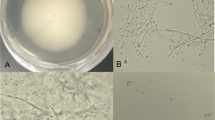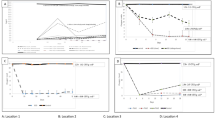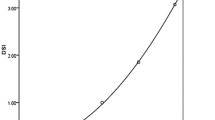Abstract
The herbicide chlorimuron-ethyl has been applied widely for weed control in farmland, especially in soybean fields in China over the past decade, but the chronic effects of this herbicide on soil microorganisms, particularly Pseudomonas spp., is not well understood. Taking a continuously cropped soybean field in the town of Fuyuan—a soybean production base of Heilongjiang Province in Northeast China—as a case study, soil samples were collected from plots having received 0-, 5-, and 10-year applications of chlorimuron-ethyl (30 g active component of chlorimuron-ethyl/ha/year) to study the abundance and diversity of Pseudomonas spp. Meanwhile, an in vitro assay was used to examine the antifungal activities of isolated Pseudomonas spp. against soil-borne pathogens (Fusarium graminearum, Fusarium oxysporum, and Rhizoctonia solani) causing soybean root rot disease. The production of siderophore, hydrogen cyanide (HCN), and lytic enzymes (cellulase, pectinase, and chitinase) by Pseudomonas spp. was also investigated. With 5- and 10- year chlorimuron-ethyl application, the numbers of soil Pseudomonas spp. decreased from 121 × 102 CFU/g dry soil in the control to 40 × 102 CFU/g dry soil and 13 × 102 CFU/g dry soil, and the Shannon index values decreased from 6.23 to 3.71 and 1.73, respectively. The numbers of antifungal Pseudomonas spp. also decreased, and the proportions of Pseudomonas spp. with antifungal activities against the different test pathogens altered. All the antifungal Pseudomonas spp. could produce siderophore and HCN but not lytic enzymes. The results suggest that long-term application of chlorimuron-ethyl in continuously cropped soybean field had negative effects on the abundance and diversity of soil Pseudomonas spp., including species with different antifungal activities against pathogens. Siderophore and HCN rather than lytic enzymes formed the antifungal metabolites of Pseudomonas spp., and the number of antifungal Pseudomonas that can produce siderophore and HCN decreased markedly under application of chlorimuron-ethyl, especially after 10-year application.



Similar content being viewed by others

References
Ahmadzadeh M, Afsharmanesh H, Javan-Nikkhah M, Sharifi-Tehrani A (2006) Identification of some molecular traits in fluorescent pseudomonads with antifungal activity. Iran J Biotechnol 4:245–253
Berg G, Krechel A, Ditz M, Sikora RA, Ulrich A, Hallmann J (2005) Endophytic and ectophytic potato-associated bacterial communities differ in structure and antagonistic function against plant pathogenic fungi. FEMS Microbiol Ecol 51(2):215–229
Bergsma-Vlami M, Prins ME, Raaijmakers JM (2005) Influence of plant species on population dynamics, genotypic diversity and antibiotic production in the rhizosphere by indigenous Pseudomonas spp. FEMS Microbiol Ecol 52(1):59–69
Chen L, Liu T, Li H, Fu L (1999) Effect of herbicides on soybean root rot and soil microorganisms (in Chinese). Soybean Sci 18(2):115–119
Chen H, Yao J, Wang F, Bramanti E, Maskow T, Zaray G (2009) Acute toxic effects of three pesticides on Pseudomonas putida monitored by microcalorimeter. J Environ Sci Health B 44:157–163
Costa R, Gomes NCM, Peixoto RS, Rumjanek N, Berg G, Mendon-Hagler LCS, Smalla K (2006) Diversity and antagonistic potential of Pseudomonas spp. associated to the rhizosphere of maize grown in a subtropical organic farm. Soil Biol Biochem 38(8):2434–2447
Evans FF, Seldin L, Sebastian GV, Kjelleberg S, Holmstre C, Rosado AS (2004) Influence of petroleum contamination and biostimulation treatment on the diversity of Pseudomonas spp. in soil microcosms as evaluated by 16S rRNA based-PCR and DGGE. Lett Appl Microbiol 38(2):93–98
Fu C (2006) Occurrence of soybean root rot disease and its comprehensive control strategy (in Chinese). Soybean Sci 5:13–15
Garbeva P, van Veen JA, van Elsas JD (2004) Microbial diversity in soil: selection of microbial populations by plant and soil type and implications for disease suppressiveness. Annu Rev Phytopathol 42(1):243–270. doi:10.1146/annurev.phyto.42.012604.135455
Haas D, Défago D (2005) Biological control of soil-borne pathogens by fluorescent pseudomonads. Nat Rev Microbiol 3:307–319
Kan F, Wei D, Ma L, Gao Z (2005) Improved methods of glucose oxidation/fermentation test (in Chinese). Prev Med Trib 11(3):305–306
King EO, Ward MK, Rany DE (1954) Two simple media for the demonstration of pyocyanin and fluorescein. J Lab Clin Med 44:301–307
Liu H, Dong D, Peng H, Zhang X, Xu Y (2006) Genetic diversity of phenazine- and pyoluteorin-producing pseudomonads isolated from green pepper rhizosphere. Arch Microbiol 185(2):91–98
Ma J-P, Wang Z, Lu P, Wang H-J, Ali SW, Li S-P, Huang X (2009) Biodegradation of the sulfonylurea herbicide chlorimuron-ethyl by the strain Pseudomonas sp. LW3. FEMS Microbiol Lett 296(2):203–209
Martin-Laurent F, Philippot L, Hallet S, Chaussod R, Germon JC, Soulas G, Catroux G (2001) DNA extraction from soils: old bias for new microbial diversity analysis methods. Appl Environ Microbiol 67(5):2354–2359. doi:10.1128/aem.67.5.2354-2359.2001
Miller JH (1974) Experiments in molecular genetics, 2nd edn. Cold Spring Harbor Laboratory Press, Cold Spring Harbor, NY
Raaijmakers J, Vlami M, de Souza J (2002) Antibiotic production by bacterial biocontrol agents. Antonie van Leeuwenhoek 81(1):537–547. doi:10.1023/a:1020501420831
Schwyn B, Neilands JB (1987) Universal chemical assay for the detection and determination of siderophores. Anal Biochem 160(1):47–56
Shi X, Wang M, Huang H, Guo L, Song Y, Huang J (2008) Extracellular chitinase activities of Metarhizium anisopliae and its correlation with toxicity of Brontispa longissima (in Chinese). Guangxi Agric Sci 39(3):313–316
Teng C, Tao B (2008) Effects of chlorimuron-ethyl on soil microorganism population and soil respiration intensity (in Chinese). Chin J Soil Sci 39(2):384–387
Tina SB, Carsten SJ (1998) Different toxic effects of the sulfonylurea herbicides metsulfuron methyl, chlorsulfuron and thifensulfuron methyl on fluorescent pseudomonads isolated from an agricultural soil. FEMS Microbiol Lett 161(1):29–35
Verma R, Naosekpam AS, Kumar S, Prasad R, Shanmugam V (2007) Influence of soil reaction on diversity and antifungal activity of fluorescent pseudomonads in crop rhizospheres. Bioresour Technol 98(7):1346–1352
Wang M, Zhou Q (2006) Effects of herbicide chlorimuron-ethyl on physiological mechanisms in wheat (Triticum aestivum). Ecotoxicol Environ Saf 64(2):190–197. doi:10.1016/j.ecoenv.2005.03.032
Widmer F, Seidler RJ, Gillevet PM, Watrud LS, Di Giovanni GD (1998) A highly selective PCR protocol for detecting 16S rRNA genes of the genus Pseudomonas (sensu stricto) in environmental samples. Appl Environ Microbiol 64(7):2545–2553
Wu M, Zhang X, Zhang H, Zhang Y, Li X, Zhou Q, Zhang C (2009) Soil Pseudomonas community structure and its antagonism towards Rhizoctonia solani under the stress of acetochlor. Bull Environ Contam Toxicol 83(3):313–317
Zawoznik MS, Tomaro ML (2005) Effect of chlorimuron-ethyl on Bradyrhizobium japonicum and its symbiosis with soybean. Pest Manag Sci 61:1003–1008
Zhang X, Li X, Zhang C, Li X, Zhang H (2011) Ecological risk of long-term chlorimuron-ethyl application to soil microbial community: an in situ investigation in a continuously cropped soybean field in Northeast China. Environ Sci Pollut Res 18(3):407–415. doi:10.1007/s11356-010-0381-4
Zhao C, He F (2007) Effects of long residue herbicides on agricultural development of Heilongjiang Province (in Chinese). J Northeast Agric Univ 38(1):136–139
Acknowledgments
We thank Prof. Chenggang Zhang and Prof. Likai Zhou, Institute of Applied Ecology, Chinese Academy of Sciences, for proving valuable edits on the manuscript. We thank the anonymous reviewers and editors of this paper for their insightful comments and helpful remarks. This work was supported by the National High Technology Research and Development Program (863 Program) (2012AA101403) and the National Science Foundation (No. 41071202)
Author information
Authors and Affiliations
Corresponding author
Rights and permissions
About this article
Cite this article
Wang, J., Zhang, H., Zhang, X. et al. Effects of long-term chlorimuron-ethyl application on the diversity and antifungal activity of soil Pseudomonas spp. in a soybean field in Northeast China. Ann Microbiol 63, 335–341 (2013). https://doi.org/10.1007/s13213-012-0479-7
Received:
Accepted:
Published:
Issue Date:
DOI: https://doi.org/10.1007/s13213-012-0479-7



